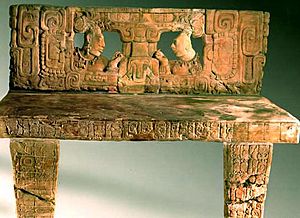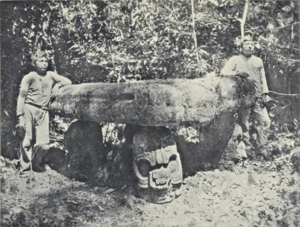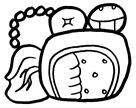Piedras Negras (Maya site) facts for kids
Piedras Negras is the modern name for an ancient Maya city. It's located on the north bank of the Usumacinta River in northwestern Guatemala. This city was one of the most powerful Maya centers along the Usumacinta River. People lived in Piedras Negras from the Late Preclassic period onwards. We know this from old writings found on stone monuments called stelae and altars.
Piedras Negras is famous for its many sculptures. Because there are so many sculptures and clear dates linked to the lives of its leaders, archaeologists have been able to learn a lot about the city's political history and its influence on other areas.
Contents
Where is Piedras Negras?
Piedras Negras is in the southern lowlands of what is now Guatemala. It sits along the eastern banks of the Usumacinta River. The city is built around open areas called plazas, not in a grid pattern. It's also built into hills, which helped protect it. Today, the area is covered in thick forests.
What Does the Name Mean?
The name Piedras Negras means "black stones" in Spanish. Its ancient Maya name was Yo'k'ib. This name means "great gateway" or "entrance." It might refer to a large, dry sinkhole nearby. It could also mean that the city was an important stop on trade routes. Some experts think the name might be "Paw Stone," but it's more likely the name of the city's founder, as shown on Throne 1 and Altar 4.
History of Piedras Negras
Piedras Negras was first settled around 700 BC. Its population grew a lot twice. The first time was around 200 BC, during the Late Preclassic period. After that, the population went down.
The second big population growth happened in the Late Classic period, around the late 700s AD. At its peak, about 2,600 people lived in the main city. The entire area controlled by Piedras Negras might have had about 50,000 people.
Piedras Negras was an independent city-state for most of the Early and Late Classic periods. Sometimes, it made alliances with other states. It even paid tribute to some others at times. It had a special alliance with Yaxchilan, a city about 40 kilometers up the Usumacinta River in Mexico.
Pottery found at the site shows people lived there from the mid-600s BC until 850 AD. The most impressive sculptures and buildings were made between 608 AD and 810 AD. However, Piedras Negras was already an important city around 400 AD.
Panel 12 from Piedras Negras shows three rulers from nearby cities as captives of Ruler C. One of them might be the ninth king of Yaxchilan, Joy B'alam. This suggests that Piedras Negras became powerful over the middle Usumacinta River area around 514 AD.
The sculptures from the Late Classic period in Piedras Negras are known for being very beautiful. The site has two ball courts and several plazas. There are also palaces with arched roofs and temple pyramids. One pyramid is even connected to a cave. Near the river, there's a large rock with the city's emblem, Yo’ki’b, carved into it.
A special thing about the monuments at Piedras Negras is that they often have "artists' signatures." This means we can identify individual artists by the unique symbols they used on their carvings.
Ruler 7 of Piedras Negras (who ruled from 781-808 AD) was captured by K'inich Tatbu Skull IV of Yaxchilan. This event is written on Lintel 10 at Yaxchilan. Piedras Negras might have been abandoned soon after this happened.
Before the city was completely abandoned, some monuments were intentionally damaged. Images and writings of rulers were defaced. Other monuments were left untouched. This suggests there might have been a revolt or a conquest by people who could read Maya writing.
Early Rulers
We don't know much about the earliest rulers. But, excavations show buildings from the Early Classic period. Altar 1 is dedicated to Ruler A, from 297 AD.
- K'an Ahk I: Ruled around 297 AD.
- K'an Ahk II: Ruled around 460-478 AD.
- Yat Ahk I (or Turtle Tooth): Ruled from 510-514 AD. Panel 2 mentions him and says he had a powerful overlord from another city.
- Ruler C: Ruled from 514-534 AD. Lintel 12 shows Ruler C with four captives, including Knot-eye Jaguar of Yaxchilan. Stela 30 and Stela 29 celebrate important time periods during his rule.
Late Classic Rulers
- K’inich Yo’nal Ahk I: Ruled from 603-639 AD. He led many military victories in the Usumacinta area. He defeated Palenque in 628 AD and captured one of its lords. Stela 25 celebrates him becoming ruler. After he took power, he destroyed older monuments and buildings to show his new rule. He also started building and fixing up older buildings to establish his family's importance.
- Dedications: Stelae: 25, 26, 31
- Itzam K'an Ahk I: Ruled from 639-686 AD. He was the son of K’inich Yo’nal Ahk I. He continued his father's military campaigns. In 662 AD, he won a victory over Santa Elena, which is shown on Stela 35. Panel 15 celebrates the capture of an unknown city and captive. This was ordered by his son after his death.
- Dedications: Panels: 2, 4, 7; Stelae: 33, 34, 35, 36, 37, 38, 39; Throne: 2
- K’inich Yo’nal Ahk II: Ruled from 687-729 AD. He was the son of Ruler 2. All eight of his stelae are in the West Group, showing he moved away from the South Group used by his ancestors. He is known for his marriage and military defense. He married Lady K’atun Ajaw from Namaan in 686 AD. This marriage was important for both cities. While he lost some battles, he defeated Yaxchilan in 727 AD, capturing one of their lesser lords. This is shown on Stela 8. His tomb is known as Burial 5.
- Dedications: Altar 1; Panel: 15; Stelae: 1, 2, 3, 4, 5, 6, 7, 8
- Itzam K'an Ahk II: Ruled from 729-757 AD. He was the son of K’inich Yo’nal Ahk II. Most of his stelae were in the West Group. A royal burial, Burial 13, was found in 1997. It was similar to Burial 5, but some bones were missing or burned. This suggests the tomb was re-entered later. Re-entering tombs was important to the Maya, showing that Ruler 4 was highly respected.
- Dedications: Altar: 2; Stelae: 9, 10, 11, 22, 40
- Yo’nal Ahk III: Ruled from 758-767 AD. He was the son of Ruler 4. His stelae were placed in the East Group, showing a move from the South and West Groups.
- Dedications: Stelae: 14, 16
- Ha’ K’in Xook: Ruled from 767-780 AD. He was the brother of Yo’nal Ahk III and son of Ruler 4. He stepped down in 780 AD, according to Throne 1.
- Dedications: Stelae: 13, 18, 23
- K'inich Yat Ahk II: Ruled from 781-808 AD. He was the son of Ruler 4 and brother of Yo’nal Ahk III and Ha’ K’in Xook. He continued to use the East Group for his stelae. In 785 AD, he ordered the creation of Throne 1, one of the best sculptures from Piedras Negras. He led many military campaigns, including defeating Santa Elena in 787 AD and fighting wars with Pomoná. Stela 12 shows him with another lord, judging captives from Pomoná. His campaigns ended in 808 AD when he was captured by K’inich Tatb’u Skull III, the ruler of Yaxchilan.
- Dedications: Altar 4; Stelae: 12, 15; Panel: 3; Throne: 1
Decline of Piedras Negras
Ruler 7 is the last known king of Piedras Negras. His capture effectively ended the ruling family that had governed since 603 AD. However, even before his capture, the city seemed to be weakening. When Throne 1 was found in 1930, it was shattered. Later excavations showed signs of burning and destruction throughout the site, especially at the royal palace.
The long-standing conflict between Piedras Negras and Yaxchilan played a big part in the city's instability. This conflict wasn't just about fighting; both cities used their art to show off their power. Even though new monuments weren't built after the 800s, people still lived at the site for a while. Piedras Negras was completely abandoned by 930 AD. We don't have archaeological proof of anyone living there after that time.
Understanding Maya Writing
Tatiana Proskouriakoff made a huge breakthrough in understanding Maya hieroglyphs by studying the many stone monuments from Piedras Negras. She realized that the stelae showing a person in a special carved space, along with the writings, actually told the life story of a ruler. These writings included important dates like their birth and when they became king.
Proskouriakoff's work changed how people thought about the ancient Maya. Instead of seeing them as peaceful people focused on stars, she showed they actively recorded their political and social history.
List of Rulers
| Name | Glyph | Reigned from | Reigned until | Monuments | Notes |
|---|---|---|---|---|---|
| K'an Ahk I |  |
c. 297 AD | Ruler A was later captured by Moon Skull of Yaxchilan. | ||
| K'an Ahk II |  |
c. 478 AD | |||
| Yat Ahk I |  |
c. 510 AD | |||
| Ruler C | June 30, 514 AD | c. 520 AD |
|
||
| K'inich Yo'nal Ahk I |  |
November 14, 603 AD | February 3, 639 AD |
|
Some experts believe K'inich Yo'nal Ahk I started a new ruling family in Piedras Negras. |
| Itzam K'an Ahk I |  |
April 12, 639 AD | November 15, 686 AD |
|
|
| K'inich Yo'nal Ahk II |  |
January 2, 687 AD | c. 729 AD |
|
|
| Itzam K'an Ahk II |  |
November 9, 729 AD | November 26, 757 AD |
|
There is evidence that Itzam K'an Ahk II began a new family line of rulers at Piedras Negras. |
| Yo'nal Ahk III |  |
March 10, 758 AD | c. 767 AD |
|
|
| Ha' K'in Xook |  |
February 14, 767 AD | March 24, 780 AD |
|
He either died or gave up his rule. Scholars are not sure if March 24, 780 AD is his death date or burial date. |
| K'inich Yat Ahk II |  |
May 31, 781 AD | c. 808 AD |
|
He became ruler almost a year after Ha' K'in Xook. He was later captured by K'inich Tatbu Skull IV of Yaxchilan. |
Modern Discoveries at the Site
The site was first explored, mapped, and its monuments photographed by Teoberto Maler in the late 1800s.
Archaeological projects at Piedras Negras were carried out by the University of Pennsylvania from 1931 to 1939. More work was done from 1997 to 2000 by Stephen Houston and Hector Escobedo.
Mayanist Tatiana Proskouriakoff was the first to figure out the names and dates of a Maya ruling family from her studies of the monuments here. This was a huge step in understanding the Maya Script. Proskouriakoff was buried at Piedras Negras in 1985.
In 2002, the World Monuments Fund gave $100,000 to help preserve Piedras Negras. Today, it is part of Guatemala's Sierra del Lacandón national park.
See also
 In Spanish: Piedras Negras (sitio arqueológico) para niños
In Spanish: Piedras Negras (sitio arqueológico) para niños





